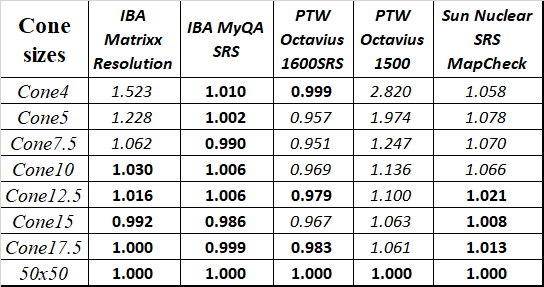Detector specific output correction factors in small fields for different 2D detector arrays
PO-1564
Abstract
Detector specific output correction factors in small fields for different 2D detector arrays
Authors: Eduard Gershkevitsh1, Ignasi Mendez2, Bozo Casar2
1North Estonia Medical Centre, Radiotherapy, Tallinn, Estonia; 2Institute of Oncology Ljubljana, Radiophysics, Ljubljana, Slovenia
Show Affiliations
Hide Affiliations
Purpose or Objective
IAEA TRS-483 has greatly improved the methodology of small field
dosimetry of megavoltage photon beams by introducing and providing detector specific
output correction (DSOC) factors for many different detector types. However, TRS-483
does not contain DSOC factors for 2D detector arrays designed for measurements
in small fields. The purpose of this study was to determine DSOC factors for
five different commercially available 2D detector arrays using W1 scintillator (Standard
Imaging, WI, USA) and EBT3 Gafchromic (Ashland, NJ, USA) films as reference
detectors.
Material and Methods
Five different 2D detector arrays (IBA Matrixx Resolution, IBA MyQA SRS,
PTW Octavius 1600 SRS, PTW Octavius 1500 and SunNuclear SRS MapCheck) were
studied. The arrays were sandwiched between Virtual water (Med-Cal Inc., WI)
slabs positioning the effective point of measurements at 10 cm depth, SSD=90
cm. 7 cm slabs were placed below the detector arrays for backscatter. The
detector arrays were irradiated on TrueBeam linear accelerator equipped with
stereotactic conical collimators (ø 4, 5, 7.5, 10, 12.5, 15, 17.5 mm) with 6 WFF,
6 FFF and 10 FFF beams. The measured output factors were compared to the relevant
reference values obtained in water phantom with W1 scintillator and in Virtual
water with EBT3 Gafchromic films for the same set-up as it was used for 2D
detector arrays.
Results
The measurement results were corrected for dose-rate dependence which
some of the detector arrays have exhibited. Max variation of 9% was observed
for 10 FFF beam in the dose-rate range 400 - 2400 MU/min (PTW Octavius 1600
SRS). The DSOC factors for 6 FFF beam are shown in Table 1. DSOC factors were
within ±3% for most of the studied detector arrays, for the cone size 12.5 mm
and above. Largest DSOC factors were
found for the smallest cone sizes. However, PTW Octavius 1500 array had a
correction factor higher than 5% even for the largest 17.5 mm cone. The highest
congruence with output factors obtained with reference detectors showed IBA
MyQA SRS 2D detector array having DSOC factors within 2% for all cone sizes.
Table 1 – Detector specific output correction factors for 6 FFF beam generated
by TrueBeam linear accelerator for five different 2D detector arrays (values in
bold are those that fall within ± 3%). DSOC factors were obtained by using W1
scintillator and EBT3 Gafchromic films as reference detectors.

Conclusion
The detector specific
output correction factors were determined for five commercially available 2D
detector arrays. They can be used to correct the readings for output factors in
small fields. Some of the arrays exhibit dose-rate dependence which need to be
accounted for when there is a difference between calibration and measurement
field sizes.